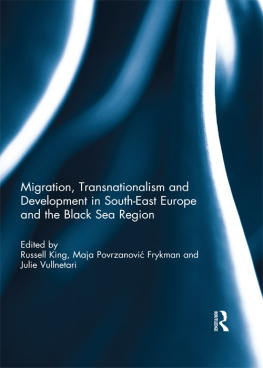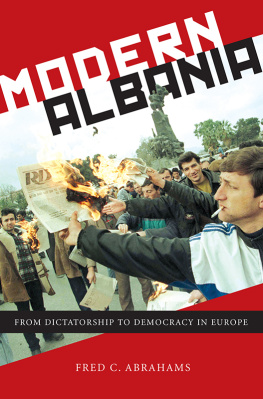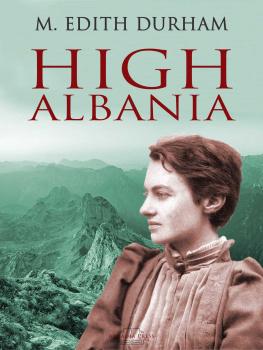Published in 2008 by
Berghahn Books
www.berghahnbooks.com
2008, 2011 Russell King and Nicola Mai
First paperback edition published in 2011
All rights reserved. Except for the quotation of short passages for the purposes of criticism and review, no part of this book may be reproduced in any form or by any means, electronic or mechanical, including photocopying, recording, or any information storage and retrieval system now known or to be invented, without written permission of the publisher.
Library of Congress Cataloging-in-Publication Data
King, Russell, 1945-
Out of Albania : from crisis migration to social inclusion in Italy / Russell King and Nicola Mai. -- 1st ed.
p. cm.
Includes bibliographical references and index.
ISBN 978-1-84545-544-6 (hbk) -- ISBN 978-0-85745-164-4 (pbk)
1. Albanians--Italy. 2. Albania--Emigration and immigration. 3. Italy--Emigration and immigration. 4. Albania--Economic conditions--1992- 5. Albanians--Italy--Social conditions. 6. Albanians--Italy--Economic conditions. 7. Italy--Ethnic relations. I. Mai, Nicola. II. Title.
DG457.A7K56 2008
305.891991045--dc22
British Library Cataloguing in Publication Data
A catalogue record for this book is available from the British Library
Printed in the United States on acid-free paper.
ISBN 978-1-84545-544-6 (hardback)
ISBN 978-0-85745-164-4 (paperback)
PREFACE AND ACKNOWLEDGEMENTS
Like many research monographs, this book derives from a funded research project. Our first debt of gratitude, therefore, is to the Leverhulme Trust, which financed the research project Albanians in Italy and Greece: A Study in Migration Dynamics and Social Exclusion (grant no. F/00230/D) over the two years 200103. This research was based at the University of Sussex (Sussex Centre for Migration Research). Russell King was the grant holder, and he, together with Nicola Mai, worked on the Italian and Albanian parts of the project, on which this book is based. The Greek part of the study was carried out by Gabriella Lazaridis and Maria Koumandraki, then of the University of Dundee, now at the University of Leicester. It is important that we acknowledge here the input of Dr Lazaridis into the planning of the overall research project and the framing of some of the research questions.
Our fieldwork to collect the research material which forms the heart of this book took us to many parts of Albania and to three cities and regions in Italy: to Lecce in the southern region of Apulia, to Modena in the northern region of Emilia-Romagna, and to Rome. In each of these places we collected carefully monitored samples of in-depth interviews with migrants, together with interviews with various key informants. Three field visits were made to Albania: a reconnaissance trip at the beginning of the research, and two longer trips in which most of the interviews were taken. Most of the interviews were done by Mai, who worked full-time on the Leverhulme project; King participated in some of the fieldwork in Albania and Rome, as time allowed.
Although the Leverhulme research forms the core of this book, we also draw on parts of two other research projects in which we have both been involved. The first is Mais Sussex DPhil thesis, which immediately predated the Leverhulme research, and was on the role of Italian television, received in Albania, in framing young Albanians migratory projects and evolving identities. The second was research which we were commissioned to do by Oxfam into Albanian migration to the United Kingdom and its impact on alleviating poverty in Albania. This project, which ran alongside the latter part of the Leverhulme study (200203), enabled us not only to collect comparative data on Albanians living in the UK (many of whom had migrated onward from Italy) but also to spend more time investigating the Albanian context of outmigration and return.
Hence, although the book is mainly about Albanian migration to Italy, it also aspires to be a state-of-the-art sourcebook on Albanian migration generally. The fieldwork-based chapters on Italy ( deals with issues surrounding return migration, development and the future migration trends of Albania.
Many individuals showed a close and committed interest in our research, and helped in various ways. In Albania we owe particular thanks to three people: to Professor Kosta Barjaba, Director of the Department of Emigration in the Ministry of Labour and Social Affairs; to Dr Ilir Gedeshi, Director of the Centre for Economic and Social Studies in Tirana; and to Maurizio Busatti, Head of the Tirana office of the International Organization for Migration (IOM). In Italy we acknowledge the help and interest of Dr Franco Pittau of the Caritas team in Rome, Dr Ugo Melchionda of IOMs Rome office, and Professor Luigi Perrone of the University of Lecce, as well as many others too numerous to mention. At the Sussex Centre for Migration Research, four people contributed vital inputs into the research: Alessandro Drago, DPhil researcher, carried out several of the migrant interviews in Rome; Mirela Dalipaj, MPhil student and research assistant on the Oxfam project, did many of the household interviews in northern Albania and around Tirana; Natalia Ribas-Mateos, Marie Curie Post-Doctoral Fellow at Sussex, assisted with some Albanian interviews, especially with women; and Jenny Money made a magnificent contribution in editing, formatting and checking the final manuscript. We also acknowledge the time and commitment of the various individuals who transcribed more than two hundred interviews the most important raw material for this book.
Our greatest debt, however, is to the people who agreed to participate in this research as migrant interviewees and key informants. Many showed keen interest in and a sophisticated understanding of our research. We thank them for allowing us to trespass on their lives, and hope that the publication of this book will help to diffuse a more balanced and realistic picture of their situation.
Russell King and Nicola Mai
Brighton and London
January 2008
Chapter 1
INTRODUCTION
Out of Albania
In the Silver Jubilee volume of the International Migration Review, Aristide Zolberg (1989: 405) opined that, if all the world consisted of Albania on the one hand and Japan on the other, there would be no need to study international migration, for it would not exist. Two years later, the world watched agog as pictures of thousands of fleeing Albanians crammed on to creaking ships dominated the newspapers and television screens for a few days in March 1991. Later that same year, in August, similar scenes were reenacted as another exodus of Albanian boat people bore down on the coast of southern Italy. The pictures of the impossibly crowded ships containing the Albanian refugees desperate to escape a country collapsing into political and economic chaos became part of the iconography of global migration in the 1990s. The scene was cynically made into an advertising poster by the Italian clothing giant Benetton, it featured on the front cover of Myron Weiners provocative book The Global Migration Crisis (1995), and it was reissued and replayed in countless magazine articles and television documentaries on migration.









